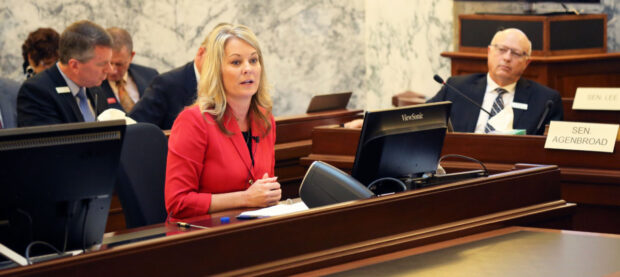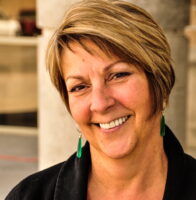Superintendent of Public Instruction Sherri Ybarra emphasized return on investment as she asked lawmakers to increase school funding by more than $100 million next year.
Ybarra made the request to the Legislature’s Joint Finance-Appropriations Committee during one of the year’s closest-watched budget hearings Thursday morning.
Ybarra devoted one hour and 12 minutes to outlining the 2017-18 public school budget request. She called for increasing public school spending by 6.7 percent, or $105.6 million above current levels — once funding for the Idaho School For the Deaf and Blind is figured in.
Her total general fund spending plan for schools rang up at $1.69 billion.

On Jan. 9, Gov. Butch Otter kicked off the 2017 legislative session by calling on lawmakers to increase school funding by 6.4 percent, or $101.4 million.
However, both Ybarra and Otter’s funding requests are likely to increase due to unexpected enrollment growth at schools across the state.
As expected, Ybarra’s top budgetary priority was increasing teacher pay under the Legislature’s career ladder salary law. Ybarra’s budget documents call for increasing teacher pay by $58 million next year, but she and Otter have signaled that number is likely closer to $62 million due to student enrollment growth.
“I agree with them both that our top priority is making sure that the career ladder is funded even though we know it is going to cost us more money because we have got more (classroom) units,” Senate Education Chairman Dean Mortimer, R-Idaho Falls, said.
If approved, next year would be the third consecutive year of raises for teachers under the career ladder’s five-year phased approach.
“This is a very important request, as it shows our commitment to invest in our human capital,” Ybarra said.
Ybarra based her budget request on three goals from her department’s strategic plan:
- Preparing students to persevere in life, college and careers.
- Mutually shared accountability for student achievement.
- Attracting and retaining quality educators.
Presenting the budget to lawmakers was a “relaxing and enjoyable” experience for Ybarra because she based her recommendation on those three goals and sought input from educators and community groups, she said.
“As the superintendent of public instruction, it is my job to get as many dollars as I can for the students of Idaho as well as the educators and make sure that is being placed where we can see a return on our investment,” Ybarra said.
Ybarra made only small changes to the preliminary budget blueprint she released back in September. Much of her budget was devoted to continuing to implement programs that were initiated over the past three years, rather than launching new programs. She stressed the importance of continuing to phase in raises for teachers and implement proposals from Otter’s Task Force for Improving Eduction.
“I really didn’t see any new things, and I would expect that because I believe this is a maintenance year, as far as new programs and new ideas,” Mortimer said. “I’m pleased that we have got a lot of good things to work on and the dollars involved are within range.”
However, there were some small changes to Ybarra’s budget. Based on feedback from educators and community members, she asked JFAC members to pull $300,000 out of her public school budget request and place it in her State Department of Education budget to pay for a proposed rural schools support network. If lawmakers go along with the move, it will win Ybarra an endorsement from the Idaho School Boards Association, which voted to support the rural schools center only if it doesn’t take funding away from the public school budget.
Ybarra also told lawmakers that it would only cost an estimated $100,000 in 2017-18 to replace the Idaho Reading Indicator test. She originally asked for $5.1 million for remediation and replacement of the reading test, which is administered twice a year to kindergarten through third-grade students.
After the presentation, several lawmakers from both political parties praised Ybarra for the level of detail in her budget request. Ybarra worked alongside nonpartisan state budget analyst Paul Headlee to satisfy JFAC’s new budget hearing procedures, which are aimed at placing a greater emphasis on the nuts and bolts of the budget and cutting down on fluff.
“That was a marathon for you and I appreciate it — it was thorough and complete,” JFAC co-chair Maxine Bell, R-Jerome, said.
Budget highlights include:
- Increasing per-classroom spending from $25,696 to $26,467 at a cost of $16.2 million once growth is figured in.
- Increasing funding for technology by $8 million, for a total of $26 million.
- Increasing professional development funding for training by $1.8 million, for a total of $18.2 million.
- Increasing funding for the math initiative by nearly $1.7 million, for a total of $3.5 million.
- Increasing funding for schools’ WiFi systems by $903,000, for a total of just over $3 million.
- Earmarking $300,000 for training administrators on teacher evaluations.
Discretionary spending for schools was one of the biggest differences between Ybarra and Otter’s budgets. Ybarra called for increasing discretionary spending by $16.2 million, while Otter called for no increase. However, Otter called for $15 million in new spending to help districts pay for increased health insurance costs, which he said would alleviate the stress on discretionary funding.
Training administrators in teacher evaluations was the other big difference. Ybarra wants to spend $300,000 in the public schools budget for that training. Otter wants to spend $2.5 million with the State Board of Education — not Ybarra’s office — for evaluations training.

In a written statement released Thursday afternoon, the Idaho Education Association applauded Ybarra and Otter’s support for teacher raises. The IEA also backed Ybarra’s proposed increase in discretionary spending.
“It is imperative that we provide local districts with as much financial flexibility as possible,” IEA President Penni Cyr said. “It is also important that we not get out in front of the State Funding Formula Task Force this is charged with developing an education funding formula for the state—they need time and autonomy to do their job.”
Overall, public school spending accounts for about 48 percent of all general fund expenses — although the exact percentage won’t be known until all budgets are finalized.
More reading: Now, the tough K-12 budget decisions fall to legislators.
